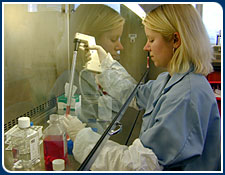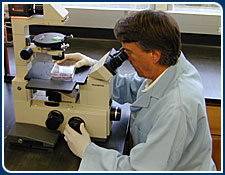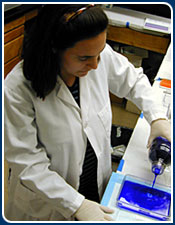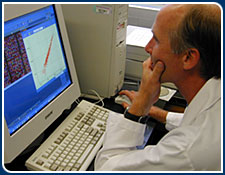|

Although it has not been proven that drusen cause ARMD, it is clear that, from
a clinical standpoint, ARMD is rarely diagnosed in their absence. By gaining a
more thorough understanding of how drusen form, therefore, the nature of the relationship
between drusen and the pathogenesis of ARMD should become evident. Historically,
our understanding of drusen formation has been hampered by the scarcity of information
on their molecular composition. We have concluded, therefore, that the identification
of their "fingerprint" at the molecular level is a necessary first step
that will provide new insight into the cellular events and biochemical pathways
involved in their formation.
Current Research on Drusen Origin and Molecular Composition

During the past 5 years, scientists working at the Macular Degeneration Centers
at the University of California, Santa Barbara and at the University of Iowa have
obtained and published a partial profile (See
Publications Archive) of the protein composition of drusen. Using antibodies
to some of these proteins as biomarkers, together with high resolution microscopic
instrumentation, some of the early cellular events that occur during the process
of drusen formation are now beginning to be elucidated. Quantitative studies of
gene expression are being used to identify the specific cell types responsible
for manufacturing the proteins found in drusen, and expression arrays of up to
10,000 different genes are now being screened for changes in gene expression that
may be involved in drusen formation.
One goal of these studies is to mimic the basic elements of drusen formation in
cells grown in culture, or in a cell-free system. A second longer-term goal is
to develop transgenic rodents that form drusen-like deposits similar to those
that occur in the human eye. The development of new experimental approaches such
as these should pave the way for the development of new treatments that delay
the onset or prevent the accumulation of drusen, and thereby forestall the loss
of central vision that accompanies ARMD.
Early Cellular Events involved in the Formation of Drusen

Although drusen were first described almost 150 years ago, the earliest cellular
events involved in their formation remain unknown. Historically, theories of drusen
formation have emphasized the incorporation of RPE cell debris into drusen, abnormal
secretions of the components that comprise Bruch's membrane, or disturbances in
the transport of substances to and from the blood supply. Recently, CSMD scientists
revisited this problem using laser scanning confocal immunofluorescence microscopy
in conjunction with a set of molecular probes (i.e. antibodies) that attach to
specific proteins, lipids, and other molecules found in drusen. Using this relatively
new imaging technology, we identified novel substructural elements within drusen,
and reconstructed a tentative sequence of cellular events that precede drusen
formation.
(Visual Simulation)
In general, our results reinforce the long-held view that RPE cell death over
an extended period of time is the prelude to drusen formation. Prior to death,
"compromised" RPE cells swell in volume and display a number of other
classic signs of cellular injury. In some cases, these cells migrate away from
the intact RPE monolayer into the sub-retinal space; in other instances, however,
processes from adjacent cells migrate over the dying RPE cells, trapping the debris
against Bruch's membrane. It is this trapped cellular debris that appears to be
the initial "seeding" event in drusen formation, and that is followed
by an attempt to encapsulate the exposed debris.
In other cells and tissues, it is well known that the chronic buildup and exposure
of cellular debris in the microenvironment of cells can act as a local inflammatory
stimulus. When that occurs, the body responds by activating a complex and highly
orchestrated series of anti-inflammatory responses, all of which are designed
to eliminate the source of inflammation. If the source is not eliminated, a chronic
state of local inflammation occurs that may persist for years. Recent evidence
strongly suggests that drusen formation may be a manifestation of this type of
chronic local inflammation.
Implications for future treatments

One important finding that has emerged from these studies is the fact that virtually
all of the newly-identified proteins in drusen are functionally related to the
process of inflammation or its aftermath. These results suggest, for the first
time, that drusen may actually be a byproduct of chronic local inflammation (See Publications Archive)
at the level of Bruch's membrane. They also provide the scientific rationale for
the development and testing of new ARMD treatments that target the adverse effects
of the chronic inflammatory cycle, rather than the primary defects in the RPE
and/or photoreceptors.
This approach is not without precedent in other age-related diseases. In recent
years, it has become apparent that other diseases of aging, including Alzheimer's
disease and atherosclerosis, also have chronic local inflammatory components that
can accentuate the effects of a primary pathogenic stimulus, whatever it may be.
In the case of Alzheimer's disease, for example, there is now substantial clinical
evidence that the sustained use of anti-inflammatory agents, such as ibuprofen,
can delay the onset and slow the progression of Alzheimer's disease. By analogy,
it is reasonable to propose that those individuals in the early stages of ARMD,
particularly those with significant numbers of drusen in the macula, could benefit
from long-term anti-inflammatory therapy that is designed to delay the onset of
the more advanced symptoms of disease.
|